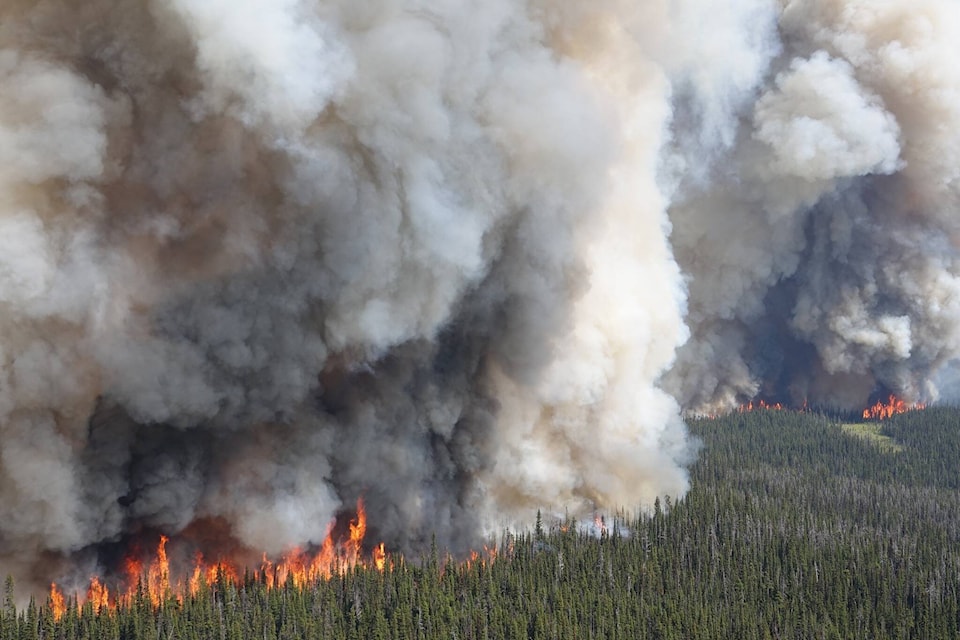Budget 2024 is promising hundreds of millions for emergency management throughout British Columbia.
Finance Minister Katrine Conroy said Thursday (Feb. 22) that the province has allocated $405 million over four years to address and protect against climate emergencies. The province has seen the impacts of climate change “through increasingly frequent and severe climate-related emergencies.”
The $405 million is broken down as $175 million for wildfire response, recovery and infrastructure, and $234 million for projects and programs aimed at decreasing flood risks and strengthening drought resiliency.
Conroy said there are many lessons to be learned from 2023’s wildfire season, “a key one being that emergency response is year-round work.” The province says statutory wildfire funding to respond to wildfires “remains available no matter the cost of a wildfire season,” but the funding will allow for year-round wildfire response and recovery activities.
For wildfire response and mitigation, the $175 million includes:
• $56 million for aviation preparedness and response with increased contract funding for helicopter and air tanker services
• $60 million for the Forest Enhancement Society of BC, which does both community- and industry-focused wildfire risk reduction and fuel management
• $38 million to support stable, year-round resourcing, including fire crew leaders and front-line staff that provide structure protection, prevention and risk reduction, and wildfire land-based recovery
• $21 million for a new Prince George equipment depot
The Prince George Fire Centre is the largest fire centre in the province, and was the hardest hit for hectares burned in 2023.
Wildfires burned about 2.9 million hectares of land in B.C. in 2023 – the worst wildfire season on record. Some of the larger wildfires — known as “holdover” wildfires — continue to burn, due to ongoing drought conditions in the province.
Emergency Management Minister Bowinn Ma said in September, toward the end of the wildfire season, that British Columbians needed to develop a water conservation mentality going forward. In emphasizing the severe drought conditions, she described it as a “sleeping giant of a natural disaster.”
For infrastructure projects and programs to decrease flood risks and strengthen drought resiliency, the $234 million includes:
• $83 million to expand the Agriculture Water Infrastructure Program, which helps farmers and ranchers manage, collect, transport and store water for agriculture and irrigation purposes.
• $50 million for water metering pilot programs in 21 communities throughout the province, which will then inform the feasibility of a universal water-metering program. That program is aimed at better conserving water, “identifying leaks” and educating users about their actual water use.
• $10 million to increase water storage capacity and better sustain the required environment water flow by raising the dam height at Saint Mary Lake on Salt Spring Island.
• $14 million toward replacing the 50-year-old Cowichan Lake Weir through a partnership with the Cowichan Tribes. A higher weir will allow for more water to be stored in the lake, which is an important source of drinking water. The replacement is also aimed better managing water flows to help improve fish habitat in the Cowichan River.
• $77 million to upgrade the Barrowtown pump station in Abbotsford. That funding was first announced on Feb. 14. The pump station was critical in responding to the November 2021 atmospheric rivers and subsequent flooding in the Sumas Prairie in the eastern Fraser Valley. Upgrades in the funding include a six-metre flood wall, replacing pump motors and replacing sandbags with concrete blocks on North Parallel Road.
READ MORE:
READ MORE:
Budget 2024 also expands support for evacuees by funding specially trained Service BC call centre agents who will provide virtual navigation for accessing information and emergency services.
In October 2023, B.C. created the Premier’s Expert Task Force on Emergencies to help inform the province how it can use lessons learned from recent climate-related emergencies and apply that ahead of the 2024 season. Recommendations from the task force are expected to be released in the spring.
READ MORE:
READ MORE:




